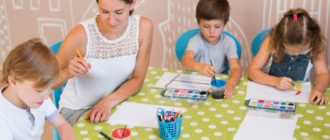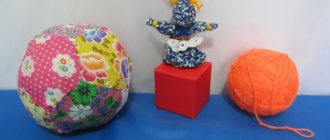Game 1. “Exchange”
In the store, children see you take money out of your wallet. Will they be able to raise the required amount themselves? The first game will teach your child to distinguish coins, change banknotes and collect the same amount in different ways.
How to play
You probably have a lot of loose change. Pour it onto the table and tell your child what types of coins there are. Let us look at them, compare size, weight, color, thickness.
Do the same with banknotes.
Explain that money is a constructor. We collect from them the amount that we give in the store for purchases. Show your child how it works: for example, collect 10 rubles from coins in several different ways (from coins of 1 ruble, 2 rubles, 5 rubles, etc. - the combinations can be different).
Now invite your child to “change” your money. Let him change you 10 rubles, 50 rubles, 100 rubles in coins.
Result
This game will teach your child to recognize and count money. Want to make the process more exciting? Invite your child to collect different combinations of the same amount of money at speed.
Game 2. “Shop”
Now the child knows that any amount can be added up from different money. What to do with this money? That's right - go to the store and pay for your purchases.
Practice going to the store at home.
How to play
Just like in childhood, only instead of leaves, take real coins and small bills.
Place “goods” on the table: toys, food from the refrigerator. Attach a price tag to each product. Agree who will be the “seller” and who will be the “buyer.”
If the “buyer” is a child, then he will have to collect the required amount of bills and coins and give it to you in exchange for the goods. If the amount is more, let him wait for the change. Then switch roles. Now the task of the child “seller” is to check whether you gave him the money correctly. And if necessary, return the change.
Result
This game teaches the child the basic principle of commodity-money relations: in order to acquire something, you need to pay for it. The seller will receive this money and use it to develop his business - buy new products or improve those he is currently selling.
Financial vocabulary for kids
- A bank is a place where people can carry out various transactions with money.
- Deposit is money that was brought to the bank and given to be kept there.
- An ATM is a device that allows you to withdraw or deposit money onto a bank plastic card.
- Assets are anything that brings in money.
- Liabilities are what take money.
- Money is pieces of paper or coins that serve as a general exchange. For example, for money you can buy anything in a store, or go to the movies. Different countries have different money.
- Card - fully called a bank payment card. This is a piece of plastic that you can use to pay for purchases in stores, online, and many other places.
- A loan is money that a person, if he lacks for something, can ask to borrow from a bank. For example, if you want to buy a computer, but you don’t have enough money, the bank can lend you money. But then the bank will have to repay the debt and pay interest.
- A bill or banknote is what paper money is called. A bill or banknote is one piece of paper.
- Cash flow or profit is the difference between income and expenses over a period of time.
The following types of coins and banknotes are currently in use in Russia:
Game 3. “Quest in the supermarket”
Previous games taught the child to distinguish money by face value and pay for purchases. It's time to test your knowledge in practice.
How to play
Invite your child to go to the store. Explain that this time he will be in charge: he will need to make sure that you bought all the planned goods and whether there was enough money for them.
1. Together with your child, make a shopping list and prepare the amount you plan to spend in the store.
Advice: let the shopping list not be long (maximum three or four items), and the amount of money not very large, so that it is easier for the child to navigate it (two hundred to three hundred rubles).
2. Walk around the store with your child. His task is to collect all the goods from the list and meet the planned amount. Draw your child's attention to the fact that goods from the same category (for example, milk) may cost differently. The price depends on the name of the manufacturer and the volume of goods.
3. Towards the end of the shopping trip, invite your child to buy an expensive item not on the list - for example, a box of sweets. If the child agrees, ask: does he have enough money? Of course, there is not enough money for everything. Then offer him options: either you refuse to purchase goods from the list and buy a box of sweets, or you put off the sweets for later and go to the checkout only with those purchases that you planned in advance.
Let the child choose.
Result
At the end of this game he will learn several things at once:
Firstly, he learns that before going to the store he needs to make a shopping list. This makes it easier not to add too much to your basket and waste all your money.
Secondly, he learns that the same goods can cost differently. And the most expensive product is not necessarily the best.
Thirdly, he learns that all purchases are divided into desirable and necessary. A box of sweets is a desirable splurge. Sweets are delicious, but if you have milk and sunflower oil at home and don’t have much money with you, you can do without sweets. That is, in this case, a box of sweets is a desired purchase, and milk and sunflower oil are necessary.
The fourth lesson is waiting for him at the checkout. The child will have to pay for purchases and check the change that the cashier will give him. Invite your child to keep the change. He can spend it on a toy or something tasty, or he can put it in a piggy bank.
Hurray, the quest is completed. Repeat it periodically with your child - this way he will soon learn to be smart about spending.
“Creation of interactive and didactic games on financial literacy of preschool children”
I would like to present my work experience in implementing the Model partial educational program for preschool education “Economic education of preschoolers”, according to which the staff of our kindergarten has been working for two years. The Program is accompanied by a collection of teaching materials and a collection of demonstration materials. These materials were prepared by the Bank of Russia jointly with the Ministry of Education of Russia.
We began our work in this direction by creating a working group, which included 9 teachers. The teachers of the working group first of all studied the program and methodological recommendations for the implementation of the main educational program of preschool education in terms of economic education of preschoolers. The program offers approximate calendar and thematic planning for senior and preparatory groups. Based on the results of studying these materials, we supplemented the calendar and thematic planning.
We have included an Approximate partial educational program of preschool education for children 5–7 years old on “Economic education of preschoolers: formation of prerequisites for financial literacy” in the Main Educational Program, in the part formed by participants in educational relations.
When implementing the program, we use teaching materials from the program collection, but since there are not enough ready-made notes for Educational Activities in the collection, the teachers and I developed most of the notes, as well as the final activities, ourselves. Thus, notes have been developed for all blocks of the program, some of them are posted on the official website of our institution. The Institute for Educational Development of the Omsk Region recently published a collection of notes on the economic education of children; it included notes developed by teachers in the city of Omsk, including us. Such material will certainly be useful to all teachers implementing this program; the collection can be purchased at the library of the Institute for Educational Development of the Omsk Region.
The next stage of the program was the creation of a developing subject-spatial environment. In two years, a developmental subject-spatial environment was developed and created for two senior and one preparatory groups. All material in financial literacy centers is periodically updated, changed, and supplemented depending on what section of the program children are familiar with; new items appear that stimulate the playful, cognitive and research activity of children.
We produced almost all the material on economic education ourselves: didactic games, albums, laptops, mini-museums, and collections, and they exist in a single copy. Therefore, all material is stored in large containers in the methodological room. The material is systematized and labeled with the necessary inscriptions and pictures, and a card index of didactic games has been compiled. As they study sections of the program, teachers of each group use materials and update or change the content of the economic education centers. All material is of different levels of complexity, it corresponds to the age and individual capabilities of children.
I present to your attention some of the materials of the developing subject-spatial environment.
Role-playing games help make economics understandable. Thus, by playing role-playing games “Professions”, children comprehend the meaning of work, reproduce the labor processes of adults and at the same time “learn” economics. In role-playing games, real life situations are simulated: purchase and sale operations, production and marketing of finished products, etc. For economic role-playing games, a cash register is introduced, checks, cards, and money are prepared. For such games, teachers made two models of an ATM, and also sewed uniforms for bank employees. With the help of the game, children clearly, in an accessible playful form, learn to use money, a plastic card, learn the algorithm for operating an ATM, and improve their counting skills using money.
To more clearly explain the topic “Where did the money come from?” We created a mini-museum “What money used to be.” The purpose of creating a mini-museum is to get acquainted with the history of the origin of money. The museum displays items that served in ancient times instead of money; goods were exchanged for them in different countries: shells, salt, tea, dried fish, feathers, fur, coffee. Children learn about this not only from the teacher’s story, but also by looking at the mini-exhibits.
To implement the second block of the program, we collected amazing collections of coins and banknotes; collections were collected by both teachers and parents. These collections contain coins and banknotes from different countries: Turkey, Kazakhstan, Belarus, Ukraine, Egypt, Poland, America, England, Bulgaria, Vietnam, China, Uzbekistan and many others.
Also in the collection there are unique coins from the times of Alexander I, Nicholas I, Nicholas II, we also have coins from 1810, 1830, 1842, 1896, 1915, 1916. Children are always interested in looking at them and comparing them with modern coins. Each coin and bill are in special albums that were purchased by us, all cells are signed and each coin and bill has its own place in the album.
For corners of the economy for each age group, teachers have developed laptops; they contain educational games in pockets, for example, “Choose something that cannot be sold and bought,” “I need and want,” and a dictionary of economic terms, and children’s drawings on the topic “ Children's fantasies about money." Lapbooks on financial topics can be used not only in class, but also for individual work with children. The contents of lapbooks can be expanded and complicated.
Our teachers use didactic games as a means of developing financial literacy. The main goal of didactic financial games: the formation and consolidation of economic knowledge. There are very few ready-made games on economic education for preschool children, so for each section of the program, teachers at our institution developed and created didactic games.
For example, the game “Who works, who plays” belongs to the first block of the “Labor and Product” program.
The purpose of this game is to consolidate ideas about the difference between work and play activities (work - play).
Two children can play the game, each in turn selecting cards, one with work activities, the other with play activities. Children describe images, name processes, establish the presence or absence of a result of labor.
The purpose of the didactic game “What do monetary units of different countries look like” is to familiarize children with the names of monetary units of different countries of the world.
To successfully conduct the game, you must first have a conversation with the children about the countries depicted in the pictures and the main attractions of this country. Explain that each country has its own flag and its own monetary unit (money), which differ in design from the money of other countries; they can depict historical monuments or the ruler of the country. The child is given a country card and must select the corresponding banknote.
This game features cards from the countries of Russia, China, Great Britain, Egypt, the United States of America, and Turkey.
Another didactic game we developed is called “Family Budget.”
Its goal is to develop children's knowledge about family expenses and income.
The game is played by 2-3 children (2 players and one leader). One player collects cards with family income, and the other with expenses. The presenter shows the cards one by one. The one who collects his cards the fastest wins. For example, family income: salary, pension, benefits, scholarship, expenses - utility bills, education, transportation costs.
The third section of the program “Advertising: truth and lies, mind and feelings, desires and possibilities” includes the didactic game “Pick up everything you need to create an advertisement.”
The purpose of this game is to develop knowledge about professions related to the creation of advertising.
During this game, children get acquainted with professions related to the creation of advertising, these are the professions of a photographer, cameraman, make-up artist, director, advertising agent. Players must also match each profession with its labor items.
To consolidate the knowledge of the fourth block of the program “Useful economic skills and habits in everyday life,” the Didactic game “Let’s Save Together” was created .
The purpose of this game is to introduce children to the rules of rational use of energy, heat, and water resources in everyday life.
Game description
Cards were produced on the topics “Save light”, “Save heat”, “Save water”, “How to save gas”. For each card, children must choose the correct pictures, for example, to save heat, you need to close windows and doors, to save water, you need to turn off the tap.
Children play the game with pleasure, they develop a stable environmental motivation “good - bad”.
3. After playing with children, you can formulate rules for saving resources.
1) Don't turn on the light if it's still light outside!
2) Turn off the lights during the day - save energy!
3) Left the room, turn off the light!
4) When you leave home, turn off all electrical appliances!
5) Insulate windows and doors - take care of the heat!
For more effective work on the economic education program for preschoolers, a bank of interactive games was created. Interactive games, as well as didactic ones, were developed for each block of the program; they are actively used by teachers in work on financial literacy: “Guess the professions”, “Where can you see advertising”, “Place the goods on the shelves”, “Create your own advertising”, “Expensive or cheap”, “Labor, product of labor”, “Money, coins, banknotes”, “Change a coin”, “Where the money is stored”. The purpose of interactive financial games is the formation and consolidation of economic knowledge using the method of interactive games.
To create an interactive game on financial literacy we need:
1.Create a blank slide in Powerpoint
2. add background
3.Insert an animated character in GIF format
4.Voice it in a special program with your own voice
5.The audio file format of the voiced character must be in Wav format
6.Insert voiced audio format to animated character
7.Next, insert the empty slide again
8.Add a background, such as a sports store window
9.Add pictures of the cart to this background,
Salesman
Product rack
10. Place the necessary items in the cart. We attach a trigger to each item that should be on the shelf and set the path along which this item should move. A trigger forces an object to move in a given direction
11. We attach a sound to each object, for example, a bell. Extra items are highlighted with a different, louder sound.
12. The final slide is an animated character with words of approval and praise for children for correct answers.
In our interactive financial literacy games, we use an animated character, Little Fox, who speaks tasks that children can understand. The little fox is present in the Program for the economic education of children. We believe that the use of an animated character will enhance children's emotional perception and interest in interactive financial literacy games.
We have developed interactive games as well as didactic games for each block of the program. For example, the game “Arrange the coins” is included in the “Money and Price” block. In this game, the little fox tells the task to the children. Children must collect coins, arranging a coin row in ascending order, starting from one kopeck to 10 rubles. If the child makes a mistake and chooses the wrong coin, the game prompts it to the correct place.
The next game is called money classification.
Click on the little fox. Little Fox introduces children to different types of money.
In the game “Where is the money kept?” the little fox sets the task Click on the little fox!!!
— the child must collect coins in a piggy bank, paper bills in a wallet, plastic cards in a bank. One, two, three children can play this game.
The next game we created is “What money can and cannot buy.” The purpose of this game is to develop an understanding that not everything can be bought with money.
Children from the cards offered must choose on the left side what can be bought with money, and on the right side what cannot be bought. For example: you can buy furniture, clothes, a house, toys. You cannot buy love, air, a feeling of joy, a good mood, a river.
You cannot buy respect, care, help, you can buy a toy, a T-shirt.
Interactive games were created on the topic “Advertising: truth and lies, mind and feelings, desires and possibilities ,” the purpose of these games is to consolidate children’s ideas about the purpose of advertising.
The cat Matroskin has a large farm, there are many cows on the farm and they give a lot of milk. The guys need to help Matroskin sell milk and dairy products. The guys are asked the question: How can we sell dairy products?
(After correct answers) the teacher suggests creating a billboard layout.
Which of the proposed heroes can be placed on a billboard? (Sharik, Uncle Fyodor, postman Pechkin) the rest of the heroes are superfluous and go into the book.
It turns out to be an advertising board for Matroskin the cat.
The goal of the interactive game “Place the goods correctly on the shelves” is to develop the ability to group goods according to their properties and purpose.
For example, in the children's goods department it is necessary to put toys on shelves. In addition, we draw the children’s attention to the fact that the shelves contain goods from other departments. Children must place this item in the cart.
The calendar and thematic planning, which was compiled by our working group, provides for the holding of final events after studying the blocks of the program. We use different forms of work, for example, a joint exhibition of drawings by parents and children “Professions of my family,” where children draw not only the professions of family members, but also objects of labor and tools. During the “Find the Treasure” quest, the children traveled around the country of finance, and the route was indicated on the map. At each station they were met by the hero of the country of finance: Kopeechka, Rublik, a bank employee, the children completed tasks and at the end of the game they found a treasure with coins. The children showed their knowledge that they acquired during their training in the financial literacy program.
In the preparatory group, teachers held a fair. The children prepared for it for a long time, made goods with their own hands - painted wooden spoons, plates, and drew money. Some of the children at the fair were selling goods, the other part were buyers. Children applied their knowledge about counting money, exchanging money, and trading.
Interactive excursions are a very interesting form of work. For example, to the Goznak factory.
Events were also held with employees of the bank “Visiting Rublik”, with employees of the Omsk State Historical and Local Lore Museum “History of Rublik”.
Work on implementing the program for economic education of preschoolers continues, a working group of teachers is developing OD notes, didactic games, interactive ones, looking for new forms of work, at the end of the school year there will be work to make changes to the calendar and thematic planning for the next year. In total, we have developed and created 30 interactive games, 27 didactic games for the economic education of preschool children.
I would also like to add that work is underway in this area with parents. In groups where the economic education program is being implemented, parent meetings are held on the ZOOM site, at which parents are introduced to this program, its goals, objectives, and the kindergarten also took part in the annual Interregional Parent Forum on the problems of education and development of preschool children, was a seminar was held jointly with Omsk State Pedagogical University “Economic education of preschool children in the family.”
All the work of our team in implementing the Model Partial Educational Program of Preschool Education “Economic Education of Preschool Children” not only contributes to the formation of children’s economic knowledge, but also improves the professional level of the teachers themselves.
When should you start teaching children how to handle money?
“You can play financial games with children as early as 5 years old. Although, of course, all children are different. There are children who, from the age of 4, can read and count up to 20. And at the age of 4 they will ask you to give them money so they can buy something themselves. And children who have already learned to write make their own shopping list and purchase goods strictly according to the list (even some mothers are not allowed to “spend money”, but are helped to save money).
As the child grows, the games can become more complex. You can play as a financial advisor, trader, banker. Be sure to take your child to banks, an insurance company, a tax office, a pension fund, a brokerage company, a real estate company, and even to the stock exchange (you can also visit money museums, go to a numismatist, and an antique shop). At the age of 10–12 years, children have the greatest interest in money. At this time, it is especially good to play board games: “Cash Flow for Children”, “Cash Flow for Adults”, “Monopoly”, “Monopoly with Bank Cards”.
Board and printed game "Economic Journey"
Printed board game “Economic Journey” for preschool children from 5 years old
Game developer:
teacher 1st category
Mosolova Alena Dmitrievna
Explanatory note
The modern world is quite rich in all kinds of games, board games
– this is a separate whole huge world for children.
Tabletop content
games are very diverse.
This includes: inserts, puzzles, cubes, pyramids, mosaics, various lacing, construction sets
, lotto, dominoes.
Some types of lotto and paired pictures introduce children to individual objects (dishes, furniture, animals, birds, vegetables, fruits) and introduce them to their qualities and properties. Others clarify ideas about seasonal natural phenomena (seasons, various professions). A large selection of board and printed games on a wide variety of topics: classification, generalization, comparison, counting, composing problems, associations. A huge variety of games for the development of speech of preschoolers - accumulation of vocabulary, development of phonemic processes, lexico-grammatical representations, coherent speech of children, development of cognitive interests of children, teaching foreign languages, etc. Therefore, we can say that an infinite number of games have already been created for children board
games for their harmonious development.
What is the importance of tabletop
game for child development?
Play, first of all, is the main activity of preschool children. In the words of V. A. Sukhomlinsky: “Game is the spark that ignites the flame of inquisitiveness and curiosity of children.” Therefore, board games
Naturally, they develop the intellectual and positive abilities of children, the positive emotions of the child.
Children develop memory, attention, and imagination. In the process of playing
, children develop all aspects of the child’s personality: compliance, tolerance, cooperation, as well as concentration, perseverance, the ability to complete a task, discipline - these are the qualities that children need when studying at school.
In addition, play is very important for education
preschoolers have strong-willed character traits: the ability to set a goal, find means to achieve it, and overcome difficulties.
Board games at an older age develop habits of correct behavior and help children master the rules of the game
, do not break them, “take turns”, do not get angry at peers who make mistakes in the game.
The human brain is very interestingly designed in such a way that it does not forget anything and puts everything away in its so-called “briefcase”; all lost situations and qualities in children are reinforced, assimilated, appropriated by the child, and become habitual norms of behavior. That is why, as part of the implementation of the partial program “Economic education for preschoolers: developing the prerequisites for financial literacy” (5-7 years old), I developed a printed board game to reinforce the basics of financial literacy. Together with the children, we decided to create our own economic game, came up with the rules and goal of the game. As a result, we came up with a wonderful walking game “Economic Journey”
with economic rules.
Educational purpose
games - to help children aged five to seven years old enter into socio-economic life, to contribute to the formation of the foundations of financial literacy in children of this age.
Tasks:
to form in children the understanding that money cannot be taken just like that, it must be earned,
teach to understand and appreciate the surrounding objective world (the world of things as a result of people’s labor);
apply acquired skills and abilities in real life situations;
respect people who know how to work and earn money honestly;
promote the formation and development of children's imagination, communication abilities, and interaction skills.
Purpose of the game
– reach the finish line, in this game – to the bank and put all the accumulated coins into the bank.
Game progress: players, by throwing a dice, can ride a train, an airplane, have fun on attractions, eat pizza, ice cream or other sweets, and they can also fly on a parachute and even get to the pirates. For each item you will have to incur costs and pay coins, their number is indicated on the playing field (for example, -1). But during the game you can also earn coins (the number of coins is indicated on the playing field, for example, +3) by doing good deeds, which the participant in the game must come up with independently. The essence of the game is to go to the bank and put coins in storage. The students in my group found it very interesting and exciting to create a game on their own.
Audience of the game: children from 5 years old.
Subject: basics of economics and financial literacy.
Materials for creating a game: Whatman paper, sponges, gouache, brushes, ruler, paper for making cubes, colored paper for making coins.
The game "Economic Journey" is completely author's development.









